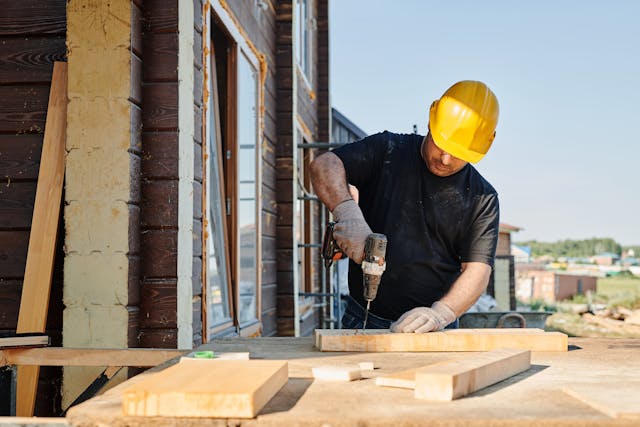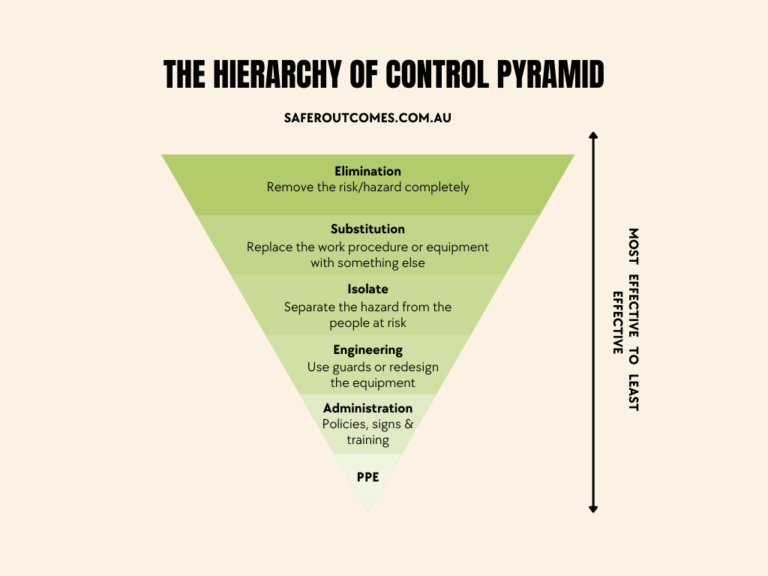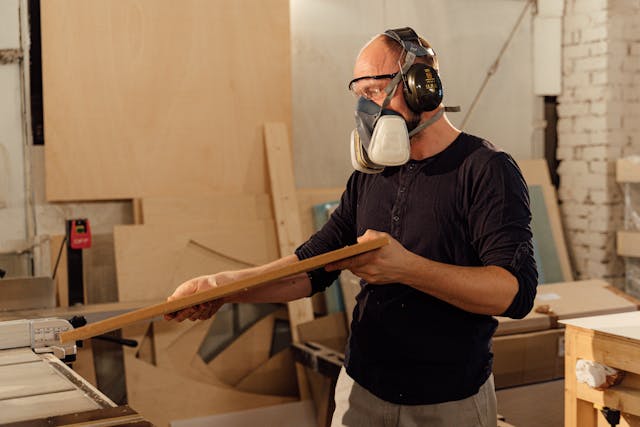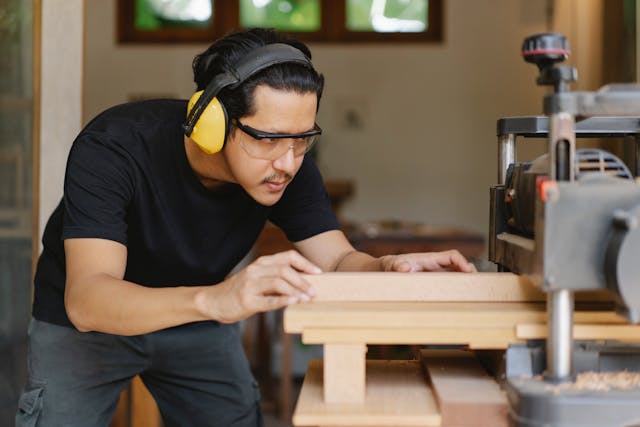Carpentry is an essential trade in the construction industry, involving a wide range of tasks from framing buildings to installing intricate woodwork. However, like all construction trades, carpentry comes with inherent risks that can threaten the safety and well-being of workers. Understanding these risks and implementing effective safety measures is crucial not only to the safety for carpenters but also for ensuring the smooth and successful completion of construction projects.
This guide is designed to provide carpenters with a comprehensive overview of the hazards they may encounter on construction sites and to outline practical safety precautions. By exploring common risks, such as power tool injuries and falls from heights, and introducing the hierarchy of control—a systematic approach to hazard management—this guide aims to equip carpenters with the knowledge and tools necessary to create a safer work environment.
In addition to discussing specific safety strategies, this guide emphasizes the importance of communication and collaboration with other trades on site, reinforcing the idea that safety is a shared responsibility. Whether you’re a seasoned professional or new to the trade, this guide serves as a valuable resource for enhancing safety practices and protecting both yourself and your colleagues on the job.

What Hazards and Risks Do Carpenters Face on Construction Sites?
Carpenters working on construction sites are exposed to a variety of hazards and risks that can significantly impact their health and safety. Understanding these risks is the first step towards effectively mitigating them and promoting safety for carpenters. Here are some of the primary hazards and risks carpenters face:
- Power Tool Injuries One of the most direct risks to carpenters is injury from power tools. This can occur when using saws, drills, or other equipment, especially if the tools are faulty, improperly used, or not maintained regularly. The severity of injuries can range from minor cuts to severe amputations, underscoring the need for strict adherence to safety protocols.
- Falls from Heights Carpenters often work at heights, whether framing roofs, installing ceiling fixtures, or working on scaffolding. Falls from such heights can lead to serious injuries or death, highlighting the importance of fall protection measures, including harnesses, guardrails, and safe ladder practices.
- Confined Spaces Working in confined spaces, such as crawl spaces or attics, presents unique challenges, including limited mobility, poor ventilation, and increased difficulty in maneuvering tools. These conditions not only increase the risk of injury but can also lead to issues like asphyxiation or difficulty escaping in an emergency.
- Exposure to Hazardous Materials Carpenters may be exposed to hazardous materials like asbestos in older buildings, chemical adhesives, or paints containing volatile organic compounds (VOCs). Inhalation or skin contact with these substances can lead to chronic health issues, including respiratory problems and dermatitis.
- Fire and Explosion Risks The risk of fires and explosions is present when carpenters are working near flammable materials, particularly when using tools that generate sparks or heat. Improper storage of flammable liquids or gases can ignite fires, endangering not only carpenters but also other workers on site.
- Manual Handling Injuries The physical nature of carpentry often involves lifting and carrying heavy materials like lumber or large sheets of plywood, which can lead to musculoskeletal injuries. Strains, sprains, and chronic back issues are common, making proper lifting techniques and ergonomics essential.
- Injuries from Falling Objects Working on construction sites often involves being in areas where objects can fall from above. Tools, materials, or debris falling from scaffolding or higher levels pose a significant risk of injury to carpenters working below.
- Repetitive Strain Injuries Carpenters frequently perform repetitive tasks, such as hammering, sawing, or sanding, which can lead to repetitive strain injuries (RSIs). These injuries, affecting tendons and muscles, can be mitigated through ergonomic practices and regular breaks.
Understanding these hazards and implementing comprehensive risk management strategies, including safety training, use of appropriate PPE, and adherence to safety protocols, are fundamental in protecting carpenters from the inherent dangers of working on construction sites.
Safety for Carpenters on Construction Sites
How to Keep Carpenters Safe on Construction Sites
Integrating the hierarchy of control into safety precautions for carpenters on construction sites provides a structured approach to managing and mitigating risks. This system prioritises risk control methods from most to least effective, ensuring that safety measures are systematically applied. Below are sections incorporating the hierarchy of control, focusing on its application to safety for carpenters in construction environments.

Understanding the Hierarchy of Control
The hierarchy of control is a framework used to manage workplace hazards and risks, categorised into several levels: elimination, substitution, engineering controls, administrative controls, and personal protective equipment (PPE). By applying this framework, carpenters and safety managers can more effectively reduce risks on construction sites and improve safety for carpenters.
- Elimination Removing Hazards: The most effective method in the hierarchy of control is to eliminate the hazard entirely. For carpenters, this could mean designing projects in a way that minimises the need for dangerous cuts or hazardous materials or planning work so that high-risk tasks can be completed when fewer people are on site.
- Substitution Using Safer Alternatives: Substitution involves replacing something that poses a hazard with a less hazardous option. This could involve using less toxic materials or selecting tools designed with enhanced safety features, such as automatic shut-off mechanisms.
- Engineering Controls Isolating People from Hazards: Engineering controls involve redesigning tools, equipment, or the work environment to reduce exposure to hazards. Examples include installing safety guards on power tools or using dust extraction systems to reduce airborne particulates.
- Administrative Controls Changing Work Practices and Procedures: Administrative controls include implementing safe work practices, such as scheduling high-risk tasks during low-activity periods, conducting regular safety meetings, and ensuring clear signage and marking of hazardous areas. Training and education on carpentry safety, risk assessments, and the development of Safe Work Method Statements (SWMS) are also key administrative controls.
- Personal Protective Equipment (PPE) Using Safety Gear to Protect Workers: As the last line of defense, PPE for carpentry is essential but should be relied on only after higher-order controls have been considered. For carpenters, appropriate PPE includes gloves, safety glasses, hearing protection, steel-toed boots, and respiratory masks for dust protection.
Implementing the Hierarchy of Control on Construction Sites
Implementing the hierarchy of control requires a proactive approach to identifying potential carpentry hazards and assessing which level of control can effectively mitigate the risk. This process should be iterative, with regular reviews of control measures to ensure they remain effective as site conditions and work scopes evolve.
Safety Planning and Continuous Improvement
Safety planning should incorporate the hierarchy of control from the project’s outset, with continuous improvement based on regular risk assessments and feedback from carpenters and other workers on site. This ensures that the most effective control measures are in place and adapted to changing conditions and new technologies, enhancing safety for carpenters.
Collaboration and Communication
Effective implementation of the hierarchy of control also relies on strong collaboration and communication among all stakeholders on a construction site, including carpenters, project managers, and safety officers. Sharing knowledge and experiences can lead to innovative solutions that further enhance safety for carpenters.
Applying the hierarchy of control in carpentry safety practices on construction sites offers a comprehensive and effective strategy for minimising risks. By prioritizing elimination and substitution, and supporting these with engineering, administrative, and PPE controls, carpenters can ensure a safer work environment. This approach not only protects workers but also contributes to the overall success and efficiency of construction projects by reducing the potential for accidents and downtime.

8 Ways Carpenters Can Keep Safe on a Construction Site
Understand and Comply with Australian Standards and Legislation
Compliance with Australian standards, and national and state-specific legislation, is non-negotiable for carpenters. These regulations are designed to uphold the highest safety standards and are regularly updated to reflect new technologies and practices. Carpenters must stay informed about these changes and understand how they apply to their work. This includes being aware of the Building Code of Australia (BCA) and any relevant codes of practice that impact carpentry work on construction sites.
Use Personal Protective Equipment (PPE)
The correct use of PPE is fundamental to a carpenter’s safety. This includes wearing gloves, safety goggles, hard hats, high-visibility clothing, and steel-toed boots. Each piece of PPE for carpentry serves a specific purpose, from preventing cuts and abrasions to protecting against falls and impacts. Regular training on the correct use and maintenance of PPE for carpentry is essential to ensure it provides the intended protection.
Implement Lockout-Tagout (LOTO) Procedures
LOTO procedures are critical for preventing the accidental activation of machinery or tools. These procedures involve disconnecting and locking the power source to prevent accidental start-up during maintenance or adjustments. Carpenters must be trained in the correct application of LOTO procedures and should never assume equipment is inactive without verifying it themselves.
Conduct Risk Assessments
Before commencing any carpentry work, a thorough risk assessment should be conducted to identify potential hazards and develop strategies to mitigate them. This process involves evaluating the work environment, the tools and materials to be used, and the potential for interaction with other trades.
Safe Work Method Statements (SWMS)
For high-risk construction work, including certain carpentry tasks, an SWMS is required. This document outlines the work to be carried out, the hazards associated with it, and the measures to control these risks. Developing and following an SWMS ensures that work is performed safely and in compliance with regulatory requirements.
Toolbox Talks
Regular toolbox talks are an effective way to communicate safety information, discuss specific hazards related to carpentry work, and reinforce the importance of following safety procedures. These brief, informal meetings can be used to review SWMS, discuss incidents or near misses, and ensure that all team members are aware of their safety responsibilities.
Communicating and Consulting with Other Trades on Site
Carpentry work on construction sites often intersects with the work of other trades. Effective communication and consultation with these trades are vital to identify and manage potential hazards that could affect safety. This includes coordinating activities to prevent overlapping work hazards and ensuring that other workers are aware of carpentry areas.
Having a Safety Plan/Manual
A comprehensive safety plan or manual is indispensable for outlining the specific safety practices, emergency procedures, and PPE for carpentry. This document should be accessible to all workers, and its contents should be familiar to the entire team. Regular training sessions can help ensure that the safety plan is understood and followed.

Safety for Carpenters Precautions on Construction Sites
Keeping Other Trades Safe Too!
On construction sites, carpenters work closely with many other skilled workers, like electricians, plumbers, and builders. It’s crucial for everyone to communicate and collaborate to stay safe. Here’s how carpenters can contribute to safety by effectively communicating with other trades.
Spotting Dangers Together
Before anyone starts their work, it’s a good idea for carpenters and other workers to discuss their plans. This way, they can:
- Have Regular Meetings: These meetings bring together workers from different trades to discuss upcoming tasks, identify potential conflicts, and plan to avoid any hazards.
- Look Around Together: Sometimes, walking around the site with workers from other trades helps spot dangers that one group might not notice on their own.
Sharing What You Know
Carpenters have valuable knowledge about the structural and material risks on a site. Sharing this information with others can greatly enhance overall safety for carpenters and other workers. They can:
- Quick Safety Chats (Toolbox Talks): These are short meetings where carpenters can explain potential hazards, especially concerning the work they’re about to do.
- Safety Messages: If there’s a new risk on site, carpenters can help by informing everyone, perhaps through a quick note or a sign.
Planning Work to Avoid Hazards
Effective planning ensures that carpenters and other workers can do their jobs without risking safety. This includes:
- Making a Schedule: It might be safer to perform certain carpentry tasks when fewer people are around. Careful scheduling can help achieve this and make it safer for carpenters and others.
- Using Signs and Barriers: Posting signs and setting up barriers around work areas warns others to be careful or stay out.
Knowing What to Do in Emergencies
If something goes wrong, everyone needs to know how to respond quickly and effectively. This includes:
- Emergency Numbers: Keeping a visible list of emergency contacts.
- Practice Drills: Running through what to do in case of emergencies, like a fire or an injury, ensures everyone knows how to react.
Using Technology to Improve Communication
Modern tools can help everyone stay informed and coordinated, such as:
- Project Apps: Apps where everyone can see updates about the work, safety tips, and any changes in plans.
- Chat Apps: Quick messaging apps can help everyone keep in touch and share information fast.
The main idea is that effective communication and collaboration help keep everyone safe. Carpenters play a vital role in this by sharing their expertise, planning their work carefully, and being prepared for emergencies. When everyone communicates well, the construction site becomes a much safer place for everyone.
Conclusion
Safety on construction sites, particularly safety for carpenters, requires more than just following rules. It involves a comprehensive approach that includes staying informed about regulations, using the right equipment, planning and assessing work, and maintaining open lines of communication with colleagues and other trades. By implementing detailed safety plans, adhering to SWMS, conducting regular toolbox talks, and fostering a culture of safety, carpenters can significantly reduce the risks associated with their work. Remember, safety is a collective responsibility and a crucial component of professional practice on Australian construction sites.
How can Safe-R Outcomes help your business improve safety for carpenters?
Our Professional subscriptions contain many essential documents including:
- WHS Management Plans / Safety Manuals
- SWMS (if the job entails high risk tasks)
- a range of SOPs, Registers, Toolbox Talks, Checklists and Policies
These can all be downloaded and are not blank templates, so can be used immediately.
We also provide Induction training to help you on-board new employees and contractors.
As you can see it is all done for you so it makes it nice and simple. You can find out more on the Industries and Professions page.
If you’re concerned about the time commitment and knowledge required to implement the correct documents, procedures and training for forklift safety, Safe-R Outcomes can help. We strive to reduce the time and cost for businesses to implement their legally necessary safety requirements. Safety for carpenters is a priority for any carpentry operation, be sure to do you part and make it a safe workplace.


